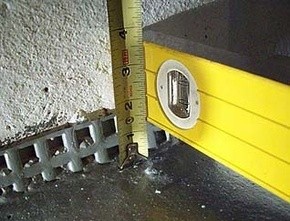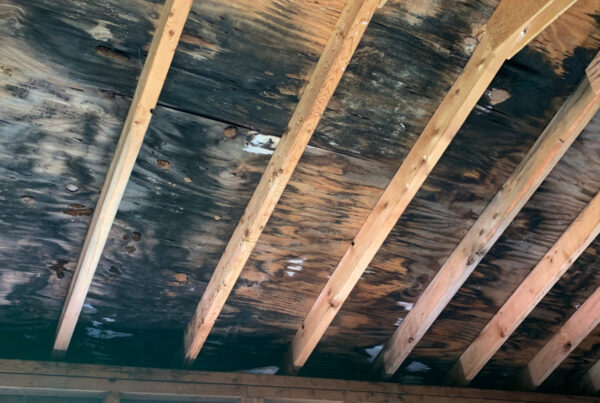Any building or home can suffer from water intrusion resulting in varying degrees of damage. Undiscovered leaks can cause damage to the interior and exterior walls, wood rot, and has the potential to create very costly repairs if the issues are not addressed promptly. For example, water can enter into a building through improperly sealed or flashed doors and windows or roof- to-wall intersections without the properly installed kick-out flashings. It is important to keep in mind that water-damaged building materials can also be extremely unhealthy, providing a breeding place for mold and mildew. A proper moisture inspection can show you where the damage is, the probable causes, and provide you with a written report that will help your repair contractor understand what repairs need to be made in order to keep the residence safe.
Water intrusion can occur in any building at any time. Investigating, evaluating and remediating these issues as they arise are very important in keeping the building’s siding, roofing and foundation in good overall condition. Whether you own a commercial building or a three bedroom townhome, these building elements will wear over time causing the building material to leak. Once the building envelope has met its remaining useful life, it has the potential to leak at multiple locations due to weathering. These locations include and are not limited to the roofing membrane, parapet wall copings, brick façade and mortar joints, lintel flashings, pan flashings, siding penetrations, and foundation wall cracking. Once water enters the building envelope, it could possibly be trapped due to the improperly installed flashings and cause further detrimental damage to the building’s structure. If the building envelope is not repaired promptly or correctly, further damage such as wood rot, mold, mildew or microbial growth, electrical shock, fire hazards, and water staining on the interior materials can occur. The homeowners or occupants within the building are affected and can become sick from the microbial growth. If wood rot is noticed on the floor or wall framing, the structural integrity of the building can be affected, creating a safety hazard for the occupants within the building. When searching for areas with large concentrations of moisture, a moisture meter is the best tool for identifying areas that need to be removed. If additional investigations are required, a professional water intrusion inspection is suggested to correctly address the issue.
A professional water intrusion inspection will determine methods to minimize future water infiltration. Preventing water from entering into the building envelope can save the homeowner or building owner future expenses—solutions may be as simple as sealing around the window assembly with a bead of caulk or installing a pan flashing at the base of a door assembly. If the exterior building weather barriers, flashings, siding materials, roofing materials, and any other exterior building materials are improperly installed, the problems that can occur are widespread and may cause other major damages. These issues could lead to large future expenses if the problem has occurred over a long period of time.
The three key steps in a successful inspection include:
- The pre-test stage: Evaluation and planning.
- The testing stage: Evaluation of existing leakage problems by recreating leaks through controlled, reproducible water testing methods.
- The observation stage: Tracing water paths and locations of water penetration using various tools including flashlights, mirrors, borescopes, and absorbent materials to check concealed spaces.
When the homeowner or building owner recognizes that there is an issue with water penetration within the building’s exterior envelope, action to remediate the problem must be taken immediately. If water enters the building envelope and the exterior building’s moisture barrier with improperly installed flashing, the water will settle within the wall assembly causing major damages over time. Mold and mildew, microbial growth, wood rot, and other issues can occur. These issues can potentially cause future structural integrity problems and health concerns for the occupants within the building. If the problem is caught at the beginning stages, it is possible to have little to no extra damage occur on the building’s structural elements.
For example, if an existing patio door on the second floor of a three bedroom condominium was removed and replaced with a new patio door without a pan flashing, water will intrude through the base of that door and enter the unit on the first floor. Over time this can cause wood rot and microbial growth within the first floor unit’s framing, ceiling, and walls. If the pan flashing was originally installed with the new patio door, this would have saved the homeowner time and money in future repairs on the floor framing, exterior wall studs, interior ceilings and wall finished materials.
When implementing a water intrusion test, the report will help the building occupant better understand where within the building envelope the water has entered through and is traveling to. As soon as the test and report are finalized and the owner, or occupant, is notified of what caused the moisture penetrations, they will need to repair the damaged area as soon as possible to remediate the problem. If the wall exhibits mold growth, the problem area cannot simply be painted over. Instead, find the source of the moisture penetration. Make sure the material that is attached to the wall in that area is removed and furniture and other items are not placed directly adjacent to this area. If the wall or ceiling has already become moldy, the removal of this material must be done when the affected area is unoccupied. The area should be removed and placed in a sealed bag to prevent distribution of any spores. If the area of moldy drywall or ceiling tiles is very large, the Environmental Health and Safety (EH&S) should be contacted immediately to assess the situation before removal has begun. EH&S should also be contacted if the leaks lead to carpet damage.
Once all the information regarding the moisture intrusion is found, reported, and remediated, the homeowner can begin to restore the damaged portion of the structure to its original condition. To do so, the homeowner, or contractor hired by the homeowner, must install the appropriate flashings, vapor and air barriers, sealant, tape, and etc. in accordance to manufacturer’s installation instructions. Keep in mind that the moisture inspection report will be necessary for the contractor working on the project to successfully repair the moisture prone area, or areas. This will ensure that the area of work will be completed in accordance to the Engineer’s professional opinions and suggestions.
Click the link below to download the publication.




